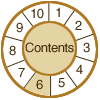

6B.
Technical Infrastructure:
IMAGE CREATION
Key Concepts
introduction
how scanners
work
scanner types
image processing
HOW
SCANNERS WORK
Scanners
operate by shining light at the object or document being digitized and
directing the reflected light (usually through a series of mirrors and
lenses) onto a photosensitive element. In most scanners, the sensing medium
is an electronic, light-sensing integrated circuit known as a charged
coupled device (CCD). Light-sensitive photosites arrayed along the CCD
convert levels of brightness into electronic signals that are then processed
into a digital image.
CCD is by far the most common light-sensing technology used in modern scanners. Two other technologies, CIS (Contact Image Sensor), and PMT (photomultiplier tube) are found in the low and high ends of the scanner market, respectively. CIS is a newer technology that allows scanners to be smaller and lighter, but sacrifices dynamic range, depth-of-field, and resolution. PMT-based drum scanners produce very high-quality images, but have limited application in library and archives scanning for reasons we'll discuss shortly.
Another sensing technology, CMOS (Complementary Metal Oxide Semiconductor), appears primarily in low-end, hand-held digital cameras where its low cost, low power consumption and easier component integration permits smaller, less expensive designs. Traditionally, high-end and professional digital cameras employ CCD sensors, despite their expense and the complexity of their design, because they exhibit much superior noise characteristics. Although some innovative designs that render low-noise CMOS-based images are emerging, CCD still dominates the high end of the market. Click here for more details on scanner operation. Further technical details on digital cameras can be found here.
© 2000-2003 Cornell University Library/Research Department